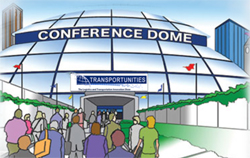 |
September 5, 2014 - Supply Chain Flagship Newsletter |
 |
| SPONSOR: TRANSPORTUNITIES |
||
 |
||
The Logistics and Transportation Insight and Solutions You Need - Without Leaving the Office |
||
October 15, 2014 |
||
 |
|
||||||||||||||||||||||||||||||||||||||||||||||||||||||||||||||||||||||||||||||||
The Coming US Logistics Cost Crack-Up?
|
|||||||||||||||||||||||||||||||||||||||||||||||||||||||||||||||||||||||||||||||||
| GILMORE SAYS: |
"A top priority of the Teamsters is to see independent owner-operators classified as company employees - which would often subject them to unionization." WHAT DO YOU SAY? |
Well, no, this is only bad news if you are a carrier or 3PL. If you are a shipper, it is good news - market factors are reducing costs overall on average as a percent of a company's sales. In fact, analyzed a bit differently, the measure could also be a proxy for the level of progress US companies are making in terms of logistics efficiency - a decline in the cost to GDP ratio is at a high level perhaps an indicator of that progress, though there many factors to sort out.
In 2007, US logistics costs were 9.8% of GDP, a year in which I guarantee most companies saw their own costs as a percent of sales rising, and found their cost much higher that year than in 2013 in percentage terms.
We have been in a mostly benign cost/rate environment since 2009. The last three years have seen some mild upward pressure on rates, but not too bad. Even the rail carriers have lately seen their pricing power fall from 5% or so quarter over quarter to more like 2-2.5%. Diesel prices have been remarkably steady, almost unnaturally so.
But is that changing? I say Yes, in many ways.
First, after years of in a sense crying wolf, the driver shortage in the US truckload sector is real - and stating to have a major impact. Analyst John Larkin of Stifel Nicolaus earlier his year said that the ability to attract and retain drivers has become the top operating variable relative to a carrier's financial success.
I don't know what the real number is - the American Trucking Associations pegged the current driver deficit at about 35,000 - but many say the situation will worsen dramatically if the economy every gets in real gear and volume rise strongly. I know this: the carriers' quarterly earnings calls are getting considerably more urgent relative to the driver shortage situation, and many are keeping the fleet sizes flat because they have no drivers to fill additional seats. Heartland Express and Celadon both recently made major acquisitions primarily to acquire additional drivers.
At NASSTRAC, a discussion session led by Werner executive basically said that to fill the void, average driver wages would need to rise from something like $46,000 annually today to something like $62,000. That is a rise of 34% - huge. Some say that isn't even enough, as some carriers such as Heartland are already there, and they still have trouble recruiting/keeping drivers.
And it's happening: Swift announced an enhanced driver pay package in July, though for now at just a 5% or so increase. Marten also recently announced a new program that will increase driver pay about 8%. Go jump on the Werner site, as I did yesterday - front and center is an announcement of a 14% wage hike.
Estimates vary, and it will be a bit different for each carrier, but wages represent some 41% of a carrier's operating costs net of fuel, which is handled mostly via fuel surcharge, according to a study a couple years ago, by the American Transport Research Institute. I have heard higher percentages cited, but let's use the ATRI's number.
A 34% increase in 41% of a carrier's cost structure says a carrier's costs, would rise some 14% over the next few years. This would inevitably be reflected in rates. That is cost increase factor number 1.
As an aside, at the NASSTRAC discussion, a manager from a very large shipper in effect said "We're not going to pay for it!" We'll see.
Number 2: The impact on productivity from the new Hours of Service rules seems to be coming in at between 2 and 3%, according to carrier reports. Importantly, this is not just driver productivity, but usually asset productivity as well.
The carriers have just lately been going to shippers and asking for hikes based on the impact of the new HOS rules. Most report some success in these discussions, which let's say are about halfway through the process. So I am going to estimate the impact of HOS changes and likely other new regs at about a 2% rise in rates.
Number 3: A top priority of the Teamsters is to see independent owner-operators classified as company employees - which would often subject them to unionization.
 There have been two union focus areas here - (1) a large group of FedEx drivers, and (2) the drayage drivers at the ports of LA/Long Beach. But don't think the long term aim is not nationwide - and it could happen quickly.
There have been two union focus areas here - (1) a large group of FedEx drivers, and (2) the drayage drivers at the ports of LA/Long Beach. But don't think the long term aim is not nationwide - and it could happen quickly.
A judge last week ruled that 2300 FedEx contract drivers in California should in fact be classified as employees. In late 2013, New York state passed a law that makes it much tougher to classify anyone working full time as an contractor, including truck drivers, the impact of which is just now starting to be felt.
Estimates are that the cost of a driver that moves from independent to union worker rises about 30%. Now, what percent of truckload drivers are contractors? I cannot yet find the answer to that. There are about 400,000 independent owner-operators total in the US. At Werner, they are 12% of the total; at Swift, about 35%.
So, let's say independents are 20% of the total - a fair estimate. Now using a slightly higher ATRI driver cost percentage (because here I am also including benefits not just wages), and you get a total cost impact of .20 * .55 (% of driver costs of total costs) * .30 (cost increase for the 20%) = 3.3%. That's less than was thinking, and of course it might not happen, but the point is it will all add up.
Number 4: The FMCSA is in the process of requiring all drivers use "digital loggers" - once called electronic on-board recorders. They will provide data in the case of accidents - but also will force carrier/driver compliance with HOS rules, versus data that can be fudged in manual log books.
While most larger carriers already use electronic loggers, most mid-size and smaller ones don't. While it may be a good thing to require all to follow the rules, those that are now forced to make the move will see their costs rise in going from partial non-compliance to full compliance. Let's estimate this at a 1% total impact.
Number 5: Diesel taxes are headed up, either to fund US infrastructure spend, or more ominously from a cost impact to reduce CO emissions. The International Monetary Fund just recommended that the US increase taxes on diesel by $1.60 per gallon to compensate for the full costs of carbon emissions.
I don't think that is happening, but I can see a doubling of the diesel tax, or an increase of about 25 cents/gallon - and possibly much more if we get a carbon tax too. That would increase fuel costs by 7%, and fuel is about 34% of a carrier's costs, so the impact would be a 2.3% rise in costs.
So here is the summary of upward cost pressure:
Wage increases: 14%
HOS impact: 2%
Contractors to employees: 3.3%
Digital loggers: 1%
Diesel tax increases: 2.3%
Total: 22.6%
That of course, is in addition to general inflation and leaves out other factors, such as the cost of new trucks rising. It would be offset by some continued improvements in diesel mileage, and less pressure on rates from more drivers entering the market, helping the current supply and demand balance. You could also switch from truckload to rail.
Still, it is a big number. Just some food for thought.
Do you think we could major increases in trucking costs in the next few years? Or is Gilmore all wet? Let us know your thoughts at the Feedback button (email) or section (web form) below.
![]()
| View Web/Printable Version of this Column |
|
|
|
YOUR FEEDBACK
We received several letters based on the two-part series guest First Thoughts contributor David Schneider wrote while editor Dan Gilmore was on vacation. Schneider argued that planning was poorly performed in most supply chain and logistics organization - and our readers seemed to agree.
That includes our Feedback of the Week from Greg Schlegel of Lehigh University. That letter and several others are below
Feedback on the Week on Getting Planning Right:
We at Lehigh University and the Supply Chain Risk Management Consortium say AMEN!
As Supply Chain Risk evangelists, we know through research that only a small portion of manufacturing organizations overtly spend time, money and resources to Identify, Assess, Mitigate and Manage enterprise-operational risks!
|
||
| More on Planning: | ||
Hi. I believe that many companies have trouble getting the planning done right and quick enough because of the lack of collaboration of the understanding of all of the employee business roles, functions and the data in a business system that can be accessed by at least the leadership positions making the planning decisions. Shelley Jordan |
||
After being around many companies and helping them with implementing planning processes enabled by software, I agree 100% with the assessment. Fast and multiple re-planning is not making it much better, but does confuse (a lot!!!), unless it is comprehensive (with who, what, when, where, why and how) and executed. I believe in technology as an enabler, but I don't believe in planning for sake of planning. Jakub Wawszczak |
||
Gavin du Plessis
|
||
I am not sure I agree with all of this, but it made some good points. What it did not address though is the aspect of time. It is one thing for a consultant to come in, charging by the hour, and do a superlative job of planning. It is another for a manager with 100 other things to do to put that same level of planning effort into a given initiative. There usually simply not enough time to do it at the level suggested here. You try to do it with enough quality that you get close to the desired results - and cross your fingers that the risk elements don't come back to bite you. It's not that most of us don't know how to do planning right, but that the time simply is not available to do so. Alex Terzanno |
SUPPLY CHAIN TRIVIA ANSWER
Q: CSCMP's annual conference will be in San Antonio this year, one of its regular venues. What four other cities are regular locations for the CSCMP conference?
A: Chicago, Denver, San Diego, and Philadelphia, though CSCMP will occasionally mix it up, such as with Atlanta last year.
| © SupplyChainDigest™ 2003-2014. All Rights Reserved. SupplyChainDigest PO Box 714 Springboro, Ohio 45066 |
POWERED BY: XDIMENSION
|









